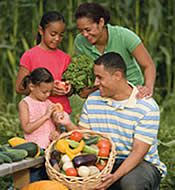Planning a Garden

- Vegetables need at least six hours of sunlight a day.
- The garden site should be relatively level. If there is a steep slope, run rows of plants across it to prevent erosion.
- It is a good idea to spade (mix) the soil to a depth of 12 to 14 inches. Adding organic matter such as manure, peat moss, or leaves will benefit the soil.
- Be careful with fertilizer. All fertilizers have a three-digit code. For vegetable gardens, look for 8-8-8 or 16-16-16.
- The simplest way to eliminate plant pests is to remove insects, worms, or eggs by hand. Some shake-on powder or liquid bug sprays are relatively safe to use.
- Proper depth for planting seeds is approximately four times as deep as the seed is thick.
If you don’t have a traditional garden plot, you can plant vegetables and herbs in containers that fit on driveways, balconies, roofs, and even window sills. This activity can be interesting and rewarding for adults and children alike.
Gardening in Containers
31106, Family Home Evening Resource
Book, Family Activities, Gardening in Containers, 307
Many people who live in apartment buildings or houses with little or no yard
space may think they cannot follow the prophet’s counsel to plant a garden. But
you can grow quite a bit of food in pots and hanging planters inside your home
or on a balcony. This activity will help you get started gardening in
containers. Even if your family has plenty of outdoor garden space, you might
want to try growing some of your vegetables indoors.Activity
You can plant in almost any kind of container. Try using plastic jugs, garbage cans, milk cartons, cans, plastic bags, baskets, a wagon bed, kitchen canisters, or clay pots. The bottom of the container should have several small drain holes and be lined with 2 to 3 inches of small gravel before you put in the topsoil. Hang containers from windows, put them on windowsills or in window wells; line your sidewalk or driveway with them, or hang them from your ceiling.The following chart shows you how much dirt you will need in a container to grow some common vegetables. This will give you an idea of what size container you need to use. It also tells you when to plant and harvest the vegetables and how big they will get. These are not the only vegetables that grow well in containers. You can try almost any kind that is common to your area.
Gardening in Containers
| COMMON GARDEN CROPS | |||||
| Crop | Container Needs | Growing Season | Planting Time | Harvest Days | Mature Size of Plant |
| Beets | 10–12 inches (25–30 centimeters) of soil | Early spring, fall | 2–4 weeks before last frost | 50–60 | 10–12 inches (25–30 centimeters) |
| Bush Beans | 8–10 inches (20–25 centimeters) of soil | Warm weather | Early spring | Snap 50–55 Lima 65 | 12–14 inches (30–60 centimeters) |
| Carrots | 10–12 inches (25–30 centimeters) | Early spring, fall | 2–4 weeks before last frost | 60–75 | 10–12 inches (25–30 centimeters) |
| Cucumbers | 1 gallon (4 liters) per plant | Warm weather | 3–4 weeks before last frost | 55–75 | Shape vines by cutting back |
| Eggplant | 3 gallons (11 liters) 12–14 inches (30–35 centimeters) diameter of soil | Warm weather | Plant indoors, transplant after 8 weeks | 120–140 | 2–3 feet (.5–1 meter) |
| Green pepper | 1 gallon (3.8 liters) per plant | Warm weather | Plant indoors, transplant after 7–8 weeks | 110–120 | 2–3 feet (.5–1 meter) |
| Lettuce | 1 gallon (3.8 liters) per plant | Cool weather, can stand slight frost | 4–6 weeks before last frost | 40–50 | 6–10 inches (15–25 centimeters) |
| Green onions | 8–10 inches (20–25 centimeters) of soil | Cool weather, can stand slight frost | 4–6 weeks before last frost | 35–45 | 10–12 inches (25–30 centimeters) |
| Radishes | 6 inches (15 centimeters) of soil | Cool weather, can stand slight frost | 2–4 weeks before last frost | 20–40 | 6–8 inches (15–20 centimeters) |
| Spinach | 8–10 inches (20–25 centimeters) per plant | Cool weather, spring, fall | 2–4 weeks before last frost | 50–70 | Plants spread out, do not grow tall |
| Squash | 5 gallons (19 liters) for a 3–4 plant hill | Warm weather, will produce through fall | 3–4 weeks before last frost | Summer 50–60 Winter 85–110 | Bush 2–3 feet (.5m–1 meter) Vine-pinch off to control runners |
| Tomatoes | Dwarf: 1 gallon (3.8 liters) Standard: 2–3 gallons (7.5–11 liters) Mini: 8–10 inches (20–25 centimeters) | Warm weather | Plant indoors, transplant after 3–4 weeks. Easily harmed by frost. | 50–90 | Dwarf: 2–3 feet (.5–1 meter) Standard: 3–5 feet (1–1.5 meters) Standard vines need support frame |
Information courtesy of The Church Of Jesus Christ Of Latter-Day Saints
Self-Reliance and Family Well-Being
No comments:
Post a Comment